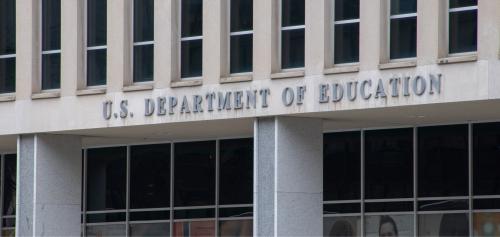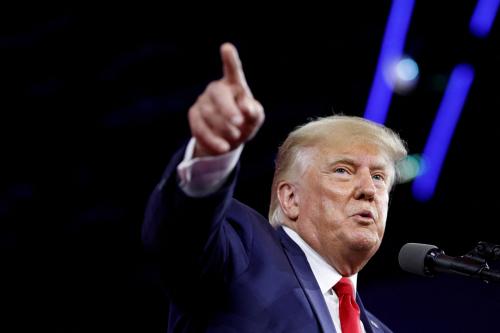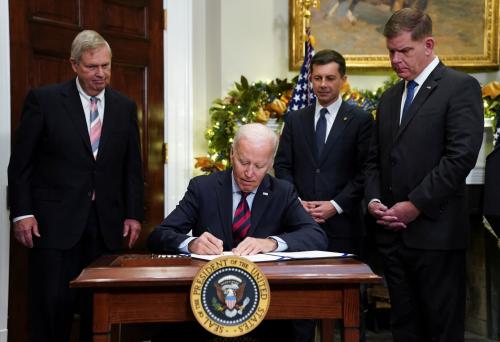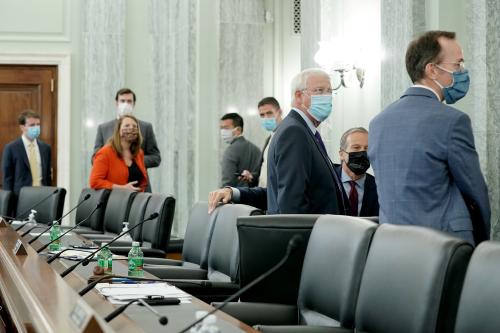In the run-up to the 2016 election, an interesting shift in the political narrative took place. International trade, which had not been much of an issue for decades and had largely been embraced by both parties, suddenly become a major topic. Two of the leading presidential candidates, Donald Trump and Bernie Sanders, made opposition to new trade agreements a central part of their campaign platforms.
The Obama administration had followed in the steps of past Republican and Democratic administrations by embracing free trade. At the time of the 2016 election, the administration was simultaneously negotiating two of the largest trade agreements in history, one among a dozen Pacific Rim economies (the Trans-Pacific Partnership or “TPP”) and another among the U.S. and EU (the Trans-Atlantic Trade and Investment Partnership or “TTIP”).
When one of the trade skeptics (Donald Trump) ultimately won, he immediately pulled the plug on the TPP and put the TTIP negotiations on indefinite hold. His successor, Joe Biden, has done nothing to revive either agreement and, in many respects, has embraced the free trade skepticism of his predecessor.
This bipartisan surge in anti-trade sentiment, though fueled by the largely inaccurate notion that free trade kills jobs, seems unlikely to dissipate anytime soon. That the TPP and TTIP would fall victim to anti-trade backlash is both unfortunate and largely unjustified because, like many modern free trade agreements, their chief focus was largely on removing unnecessary trade barriers by promoting the alignment of regulations in participant countries rather than reducing tariffs. Regulatory alignment streamlines regulatory compliance by eliminating the need to adhere to a patchwork of different national regulatory approaches. An economic populist who argues for high tariffs to save American manufacturing jobs seems less likely to argue for maintaining divergent U.S. regulations, which is a highly inefficient approach to staving off foreign competition.
Nevertheless, these recent setbacks may yet create new opportunities for advocates of international regulatory cooperation. Achieving regulatory alignment through a trade agreement is the most ambitious and also likely the most challenging possible approach. There are, however, a number of far less controversial or burdensome approaches regulators might take to promote regulatory learning and, ultimately, regulatory alignment. This report explores what those options are and how they might help advocates of regulatory cooperation chart a more sustainable path forward.
The challenges of achieving regulatory alignment through trade agreements
The early 2000s were a golden age for free trade. The George W. Bush administration entered into a series of bilateral free trade agreements with important partners like South Korea, Australia, and Chile. President Barack Obama sought to build on this momentum, pursuing an even more aggressive approach focused on negotiating multilateral trade agreements (so-called “mega-regional agreements”) among large blocs of trading partners in lieu of the traditional bilateral agreements. Negotiations for TPP began in 2008 (late in the Bush administration), and TTIP negotiations kicked off in 2013.
At the time, the case for mega-regional agreements seemed unassailable. A study by the European Center for Economic Policy Research found that the TTIP, if successful, could add €119 billion to annual GDP in the EU and €95 billion in the U.S., largely as a result of regulatory alignment. Throughout the process, both sides emphasized that neither the U.S. nor the EU would water down regulatory protections. Advocates of the TPP went even further and suggested that the agreement would likely strengthen regulatory protections in the developing Asian and Latin American participant nations, as they would have an incentive to bring their standards up to U.S., Canadian, and Japanese levels in order to achieve regulatory alignment.
The economic case for regulatory alignment remains unassailable, and other countries have continued to sign trade agreements in the absence of American participation. The difficulties of achieving regulatory alignment through the vehicle of a trade agreement are not, however, solely a function of populist backlash against free trade.
Unlike trade agreements that focus exclusively on tariff reduction, agreements involving regulatory alignment require difficult, highly technical negotiations. Modifying two or more highly complicated regulatory systems in order to achieve greater compatibility requires extremely fact-intensive discussions. The only people who possess the necessary expertise are usually agency bureaucrats who, by nature, tend to oppose any interference with their handiwork. Unless they perceive some immediate domestic benefit to upending their existing regulations, they are reluctant to do so.
Equally importantly, neither agency bureaucrats nor other regulatory experts tend to have an especially sophisticated understanding of any regulatory system other than their own. This problem became obvious very early in the TTIP discussions. To try to remedy it, the EU Commission funded a 2014 study and another study in 2015 comparing the EU and U.S. systems. At that point, however, the discussions were already well underway, and the initial impression of both sides that the other’s system was inscrutable and poorly designed proved hard to overcome.
In short, before regulatory alignment can be achieved, participating nations must achieve a far more nuanced understanding of one another’s regulatory regimes. Attempting to force alignment by mandating it through a trade agreement is often a recipe for failure or for an imperfect melding of two systems that does not account for the underlying complexities.
A better way? An incrementalist approach to international regulatory cooperation
The setbacks associated with the U.S.’s abandonment of TTIP and TPP, though unfortunate, may help advocates of international regulatory cooperation chart a more favorable, sustainable path forward.
In so doing, they should reconceive international regulatory cooperation as a multi-rung process of achieving greater and greater integration among different countries’ regulatory regimes rather than as a way to force wide-scale regulatory alignment. A free trade agreement—which frequently involves either outright harmonization of national regulations or a series of mutual recognition agreements in which each side agrees that compliance with one country’s requirements is sufficient to meet the other’s requirements—represents the top of the ladder. There are, however, numerous opportunities for achieving enhanced regulatory integration short of outright harmonization. At the lower levels, regulatory alignment may not even be an explicit goal: Agencies in different countries may simply be sharing information and learning from one another’s approaches. At the higher levels, regulators actively seek to align their regulations but recognize that doing so will generally involve an extensive, long-term process and that full alignment may never be possible.
More specifically, one might envision the following ascending rungs along the regulatory cooperation ladder:
- Mutual Regulatory Learning: National regulatory authorities, including both legislators and executive branch officials, can exchange high-level information about their respective regulatory regimes and, as appropriate, consider foreign models when designing or reforming their own systems.
- Commitment to Good Regulatory Practices: Regulatory authorities may enter into a formal agreement with key trading partners and commit both sides to so-called “good regulatory practices” (GRPs).
- Regulatory Information Exchange: National regulators can share data acquired in the course of studying a particular regulatory problem with their overseas counterparts and divide the burden of producing new information.
- Regulatory Cooperation Council: Regulators in one nation might agree to create an ongoing dialogue with regulators in another nation, attempting to align new regulations before they are enacted and to identify existing regulations that might be brought into greater alignment.
In large measure, the TTIP negotiations proved challenging because the negotiators attempted to skip the lower-level rungs, leaping all the way to the top of the ladder. The contemplated treaty was to consist of a series of mutual recognition agreements and an ongoing U.S.-EU regulatory cooperation council, but, as noted above, neither side possessed an especially sophisticated understanding of the other side’s system of regulation. In retrospect, starting at the first rung, commissioning a series of comparative studies of the U.S. and EU regulatory regimes, and then climbing to the higher rungs of regulatory cooperation would have greatly enhanced the prospects for success.
For future regulatory cooperation efforts to succeed, reformers should carefully consider each of the rungs and ensure that they have fully realized the benefits of the lower rungs before trying to move to the higher ones.
Mutual Regulatory Learning
At the most basic level, international regulatory cooperation need not involve a conscious effort to promote regulatory alignment. Merely being aware of how other nations address common regulatory problems is valuable in its own right. Indeed, regulatory experts constantly speak of the benefits of “evidence-based policymaking,” and there is no better method of promoting empirically rigorous decisionmaking than old-fashioned trial and error. Traditionally, U.S. states played the role of “laboratories of democracy,” testing different regulatory approaches and producing useful information that federal regulators could then use when designing national regulations. The increased centralization of regulatory power in the federal government has largely deprived the states of this role, but a treasure trove of data still exists at the international level, with individual nations constantly mounting different responses to common problems and either succeeding or failing.
At present, there is no organized effort to learn from any of this ongoing regulatory experimentation. Occasionally, regulators in one nation may devise a novel approach to a particular problem, and others may emulate it. For instance, the United Kingdom recently adopted a “one in, one out” system of regulatory budgeting (later expanded to “one in, three out”) that requires £1 in regulatory savings for each £1 in new regulatory costs. Canada, Germany, and, most recently, the European Union have all announced some version of a regulatory budget. The United States did the same under President Trump, who implemented a regulatory budget via executive order, though President Biden rescinded this order on his first day in office.
It is far too early to tell whether or not these budgeting efforts, which have only been around for the last decade or so, will succeed. Perhaps they will force regulators to consider the cumulative effects of their various enactments on regulated industry and start to bend or even flatten the regulatory growth curve. Alternatively, perhaps they will needlessly kneecap regulators by forcing them to focus on eliminating old rules when they should be writing new ones to address novel problems. Perhaps more likely still, some approaches to regulatory budgeting may succeed and others fail. For instance, the Canadian approach focuses solely on cutting “paperwork burden” and other types of “red tape” rather than cutting other regulatory compliance costs. The American approach under the Trump executive order focused on cutting not only the costs but the overall number of regulations. One model or a combination of models may ultimately prove superior to the others.
Unfortunately, we will most likely never know which approaches, if any, are worth undertaking since useful information on the different models is almost entirely unavailable. So far as I can tell, no nation that has adopted a regulatory budget has created a dedicated website providing even the most basic information about it, including which types of regulations are subject to the budgeting requirement, how agencies are to assess regulatory “costs,” whether agencies can “bank” regulatory savings that can later be used to impose new costs, or whether agencies can transfer regulatory savings to other agencies. As a result, academic researchers who might otherwise be interested in assessing regulatory budgeting have almost no access to useful information by which they might go about doing so.
In this light, before regulators attempt something so ambitious as harmonizing their regulations with those of key trading partners, they should first focus on ensuring they fully understand how other nations’ regulatory systems work. Something so simple as an official government website that describes the basic components of a nation’s regulatory system would be extraordinarily valuable to regulatory authorities in other nations trying to understand it. The so-called U.S. Reg Map provides an example of how a description of the rulemaking process might look, though it is issued by a private firm and therefore lacks the imprimatur of an official agency document.
Though the cost of creating such a website would likely be minimal, regulators in different nations currently have few incentives to produce such resources. An agency official would be hard-pressed to justify spending even a minimal amount of time producing something designed to benefit overseas regulators (even if it also benefits journalists, academic researchers, interested citizens, and others). Agency officials also have few incentives to rely upon information they obtain from foreign regulators. After all, the U.S. has a long tradition of looking with deep skepticism at foreign practices, as the intense backlash over Supreme Court justices’ reliance on foreign precedent demonstrates. As a 2011 study by the Administrative Conference of the United States found, U.S. regulators will likely receive little credit for discovering an innovative foreign practice but are likely to face severe criticism if any adverse consequences arise from their reliance on foreign precedent.
As a result, high-level regulatory authorities such as the U.S. Office of Information and Regulatory Affairs (OIRA) likely must play a prominent role in order to give agency officials the political cover needed to engage with foreign counterparts. OIRA might consider requesting that other nations create such a website as U.S. agencies go about creating their own. One method for obtaining such a commitment is via a memorandum of understanding (MOU), a type of nation-to-nation compact that OIRA used during the Trump administration to create a series of regulatory exchanges with key trading partners. As more and more nations participate, the data set grows richer and richer, and the value to both U.S. and foreign agencies increases.
Commitment to Good Regulatory Practices
As U.S. and foreign regulators learn from their own and others’ experiences, certain regulatory practices will emerge as commonly accepted best practices. Organizations such as the Organization for Economic Cooperation and Development have published lists of so-called Good Regulatory Practices (GRPs) that they believe all nations’ regulatory authorities should adopt. These GRPs include things such as giving notice of proposed policy changes, seeking public comment, and considering the benefits and costs of proposed regulations. Though these practices are not necessarily universal, they are broadly recognized as being necessary to optimize the quality of regulations a country produces.
As a general matter, U.S. agencies undertake all of the actions that have come to be accepted as GRPs. The APA requires notice-giving, solicitation of public comment, and evidence-based policymaking, and Executive Order 12,866 requires some form of benefit-cost analysis for most important regulations. The same is not necessarily true of the U.S.’s key trading partners, however, and U.S. regulators should seek opportunities to encourage their foreign counterparts to adopt GRPs.
A recent MOU between the U.S. and Brazil does precisely that. Among other things, it commits both sides to the following GRPs:
- Achieving enhanced coordination on both sides, including through regulator-to-regulator dialogues on good regulatory practices
- Committing to soliciting public input on regulations, providing an adequate opportunity for public comment, and responding to relevant comments
- Adhering to certain best practices when formulating regulations, including basing decisions on empirical evidence, considering the distributional effects of proposed regulations, minimizing regulatory costs and maximizing regulatory benefits, considering market-based approaches, and drafting regulations in plain language
- Publishing information related to regulations, including proposed rule text and underlying economic analyses
The MOU also provides that the U.S. and Brazil will seek out opportunities to exchange information on other GRPs that may emerge.
Of course, the mere existence of such an MOU does not guarantee that Brazil will meaningfully reform its regulatory system. For instance, unless its regulators are drawing proposed rules out of a hat, it likely can make a credible case that it is basing its regulations on “empirical evidence.” Moreover, the fact that the U.S. does not appear to have altered its own regulatory system in response to the MOU perhaps provides an incentive for Brazil merely to point to activities it has already undertaken as achieving compliance with the proposed GRPs.
Indeed, the entire notion of an MOU committing both sides to various GRPs is somewhat odd in that countries should have a strong incentive to improve their regulatory systems regardless of whether their trading partners do the same. Sometimes, however, the added inducement of a reciprocal commitment is needed to spur even self-interested behavior. The logic is similar to that applicable to tariffs: Some economists have argued that nations should unilaterally eliminate all tariffs even if their trading partners refuse to do the same. Though such an action would come at a cost to domestic producers, the benefits of lower prices to domestic consumers would be so large as to offset the costs. Nevertheless, countries seldom reduce tariffs absent a reciprocal commitment from one or more trade partners. By the same rationale, an MOU can serve as a catalyst to expand adoption of GRPs.
In this sense, the U.S.-Brazil MOU stands as a notable accomplishment in that it emerged during the administration of a U.S. President who was well-known for his opposition to free trade. Future MOUs might contain more concrete commitments. For its part, the U.S. would do well to consider committing to regulatory practices far more ambitious than it is asking its trading partners to consider. For example, in exchange for a developing nation’s agreeing to adopt a basic system of regulatory benefit-cost analysis, the U.S. may need to commit to something it is not already doing, such as fully quantifying benefits and costs for economically significant regulations. In so doing, it can leverage its commitment to enhance its own regulatory system by obtaining lesser but still meaningful commitments from trading partners.
Information Exchange
The information that regulators produce in their day-to-day work of drafting and enforcing regulations and adjudicating cases is an example of a positive externality in the context of international regulatory cooperation. For instance, an Environmental Protection Agency study on the health effects of particulate matter emissions would be highly relevant to the EU’s Directorate-General for the Environment and essentially all other environmental authorities. Unfortunately, there is no centralized system for exchanging this type of information. Even if information produced by a national regulator is publicly available, which is seldom the case, other countries’ regulators will usually come across it merely by happenstance.
Of course, regulators produce so much data in their daily affairs that the possibility of information overload is a significant concern. For every highly relevant study an agency produces, there are likely thousands of run-of-the-mill investigations that would be of little to no interest to foreign regulators. Dumping the virtual equivalent of an agency’s file cabinets on the internet would prove effectively useless to those seeking valuable information.
As a result, agencies must be highly judicious in determining what documents to publish online. Important studies, regulatory impact analyses, and the results of major investigations all may be relevant to agencies’ international counterparts. Run-of-the-mill documents such as those associated with an investigation of a small market player with no international presence may be of no interest to foreign agency officials. U.S. agencies are already required to disclose some of these materials under the Freedom of Information Act. They might also consider placing documents that are especially likely to be of interest to overseas counterparts on a dedicated page of the agency website.
In addition to sharing information they already possess with regulators overseas, agencies might consider dividing the labor involved in generating new information with trusted foreign counterparts. For example, several years ago the U.S., Australia, and Europe implemented a pilot program by which their respective drug safety agencies divided up the inspection of pharmaceutical plants in China. A recent MOU between the U.S. and Israel created a joint task force between the Israeli Ministry of Finance and the U.S. Office of Management and Budget that sought to identify regulatory reforms designed to reduce both the costs and flow of new regulations, combat excessive bureaucracy, and consider possible deregulatory approaches.
Finally, agencies should consider how to optimize international access to information they receive from the outside. The U.S. regulatory system is a model in this respect: U.S. agencies place comments they receive during the agency rulemaking process on regulations.gov, which allows foreign governments and stakeholders to view the comments. Foreign regulators that lack such a system should strongly consider emulating the U.S. model. Regulators in the U.S. and overseas may also consider how to enhance the information received from foreign stakeholders.
Unfortunately, as in the case of regulatory learning, domestic regulators have few incentives to revamp their websites to facilitate use by foreign regulators or forge joint task forces with their international counterparts. The previously mentioned Administrative Conference report found that agencies occasionally do exchange information with overseas counterparts if they perceive a direct benefit to their domestic regulatory mission, but they are otherwise highly reluctant to do so. The result is a basic public good problem: U.S. and foreign regulators would benefit from enhanced information exchange, but neither has an incentive to be the first mover and begin producing that information. Except in limited instances in which agency officials in two different countries can swap specific pieces of information, the necessary quid pro quo will usually be lacking.
As a result, high-level regulatory authorities such as OIRA may need to enter into MOUs with foreign governments providing for these sorts of information exchanges in order to furnish the necessary motivation for U.S. regulators and their foreign counterparts. Congress, too, might consider enacting laws that mandate certain types of nation-to-nation information exchanges, though it should be mindful of the resource burden this can impose on agencies and ensure that the benefits justify the costs.
Regulatory Cooperation Council
The final, most ambitious approach to international regulatory cooperation involves creating a permanent body that is responsible for maintaining an ongoing dialogue among regulatory authorities in two or more nations and explicitly identifying regulations that can be harmonized or otherwise made more compatible. The most well-developed example of this approach is the U.S.-Canada Regulatory Cooperation Council (RCC), which convenes periodic meetings between regulators in the U.S. and Canada to promote regulatory alignment.
Over the years, the RCC has released a series of Action Plans which go well beyond the high-level commitment to a handful of regulatory best practices or goals seen in the U.S.-Brazil and U.S.-Israel MOUs. For instance, the RCC’s 2011 Joint Action Plan included a variety of sector-specific regulatory alignment goals, addressing regulations in the agricultural, transportation, chemical, and environmental fields. Within each of these sectors, the U.S. and Canada committed to specific outcomes, such as creating a common meat nomenclature system and aligning side impact and ejection mitigation standards for cars.
Another MOU negotiated during the Trump administration reaffirmed and built upon the mission of the U.S.-Canada RCC. It supplemented the existing RCC framework by providing for regulator-to-regulator exchanges over the lifespan of a regulation, stakeholder involvement in promoting bilateral regulatory convergence, and the formulation of technical work plans to promote regulatory alignment.
The U.S.-Canada RCC is, in many respects, the gold standard for regulatory cooperation. Indeed, at various points during the TTIP negotiations, both sides entertained the notion of creating an EU-U.S. equivalent. Though the RCC model offers the largest potential payoff with respect to promoting regulatory alignment, it also imposes the highest cost. Requiring regulators to meet on a periodic basis and devise plans for achieving enhanced alignment in various sectors is a highly resource-intensive exercise. Every hour regulators spend on attempting to achieve greater compatibility between their own and another trading partner’s regulations is an hour they cannot dedicate to other, potentially more pressing problems.
Moreover, the complexity of the exercise increases exponentially as additional trading partners are added. Achieving enhanced regulatory alignment has been challenging enough in the context of U.S. agencies interacting with very similar Canadian ministries. Trying to forge consensus with a large number of nations simultaneously, especially if some or all of the participating countries are unfamiliar with one another’s regulatory regimes, may prove impossible.
For that very reason, regulators are better served starting at the lower rungs of the regulatory cooperation ladder, promoting enhanced learning or increased information sharing, before attempting to erect an apparatus such as the RCC that is explicitly focused on achieving regulatory alignment. As relationships deepen, the RCC model may become more attractive. But simply attempting to erect such a program in countries without a long-running history of regulator-to-regulator exchanges, as has existed in the case of the U.S. and Canada, is likely to end in failure.
Readjusting expectations
The approach outlined above may strike many advocates of international regulatory cooperation and alignment as underwhelming. For instance, American participation in TTIP and TPP would have brought about a far more fundamental transformation of its regulatory regime. Yet the hurdles U.S. representatives faced in negotiating those agreements were arguably a result of trying to do too much too quickly. Achieving regulatory alignment is difficult if not impossible when trading partners do not have a long history of mutual interactions or even understand one another’s regulatory regimes particularly well.
In this sense, these recent setbacks may yet prove beneficial to international regulatory cooperation efforts insofar as they force a reassessment of what is feasible and provide an incentive for advocates to begin the painstaking but rewarding process of building the connections necessary to sustain a more viable system. The fact that the three MOUs described above (U.S.-Israel, U.S.-Brazil, U.S.-Canada) emerged during the Trump administration, which was hardly known for its enthusiasm for international engagement, offers reason for optimism.
At the same time, as the 2011 ACUS report found, regulators currently have few incentives to undertake these efforts on their own initiative. Indeed, agencies are already technically required to consider the international implications of the rules they adopt under a still-active executive order from the Obama administration, but most have ignored this largely hortatory directive. To some extent, better marketing of regulatory cooperation initiatives could lead to enhanced buy-in among agencies. Regulators who recoil in the face of something as ambitious as the TTIP or TPP or as resource-intensive as an RCC may be open to pursuing less involved forms of regulatory cooperation, such as sharing information or learning from their international peers. This is especially likely to be the case if regulators come to see international cooperation as a way to help them carry out their domestic regulatory missions.
Ultimately, however, achieving enhanced regulatory alignment will require some degree of top-down planning from Congress, the president, and super-regulatory bodies such as OIRA. The Trump administration MOUs with Israel, Brazil, and Canada offer one possible model for achieving enhanced regulatory cooperation on a country-by-country basis. The Biden administration and future administrations would do well to build on this model and expand the cooperative network even further, adding more countries and adopting more aggressive agreements that commit the signatories to making specific changes to their regulatory regimes.
Since the wilderness years for free trade advocates seem likely to persist for the foreseeable future, they should use this opportunity to begin creating this web and proving the value of regulatory cooperation. Incremental improvement never generates the same publicity or excitement as sweeping reform, but it usually proves more successful and sustainable. Even if the populist invective against free trade never subsides, the unglamorous but rewarding process of building a more integrated network of national regulatory regimes will pay enormous dividends in increased wealth and international goodwill. If and when the Right and/or the Left rediscovers its traditional affection for free trade, this framework will help provide a sure foundation for future TTIPs and TPPs to succeed.
ACUS disclaims responsibility for any private publication or statement of any ACUS employee. The article expresses the author’s views and does not necessarily reflect those of ACUS, the federal government, or the Brookings Institution. The author did not receive any financial support from any organization or person for this article or from any organization or person with a financial or political interest in this article. He is currently not an officer, director, or board member of any organization with a financial or political interest in this article.






